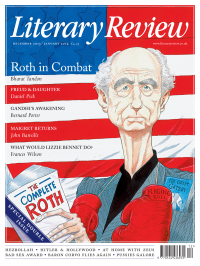Daniel Pick
Complex Relations
Correspondence 1904–1938: Sigmund Freud and Anna Freud
By Ingeborg Meyer-Palmedo & translated by Nick Somers
Polity Press 489pp £30
‘Have you read that cholera has already reached Naples? Will you be giving it a wide berth?’ So wrote Anna Freud (aged 14) in September 1910 to her father, then travelling in the south. Anna was Sigmund’s youngest child and the only one of his six to train as a psychoanalyst. She became a custodian of his movement, a pioneer of child analysis, and co-founder of the Hampstead Nurseries, which offered refuge to homeless families during the Second World War. She was well known for her fierce quarrels with Melanie Klein, whose ideas were to have a profound impact on British psychoanalysis. Anna also proved influential in this country and to a still greater extent in the United States. She never married, nor did she ever permanently leave her parental home. After she died in 1982, her – their – residence in London became the Freud Museum. Sigmund called Anna his ‘Antigone’, which captured something of her unswerving dedication.
Their letters, postcards and occasional telegrams to one another, spanning a 34-year period, have been assembled in this remarkable book, just translated from the German. In that same teenage letter mentioned above, Anna expressed her fears that Sigmund’s then travelling companion and colleague, Sándor Ferenczi, was not looking after him.

Sign Up to our newsletter
Receive free articles, highlights from the archive, news, details of prizes, and much more.@Lit_Review
Follow Literary Review on Twitter
Twitter Feed
It wasn’t until 1825 that Pepys’s diary became available for the first time. How it was eventually decrypted and published is a story of subterfuge and duplicity.
Kate Loveman tells the tale.
Kate Loveman - Publishing Pepys
Kate Loveman: Publishing Pepys
literaryreview.co.uk
Arthur Christopher Benson was a pillar of the Edwardian establishment. He was supremely well connected. As his newly published diaries reveal, he was also riotously indiscreet.
Piers Brendon compares Benson’s journals to others from the 20th century.
Piers Brendon - Land of Dopes & Tories
Piers Brendon: Land of Dopes & Tories - The Benson Diaries: Selections from the Diary of Arthur Christopher Benson by Eamon Duffy & Ronald Hyam (edd)
literaryreview.co.uk
Of the siblings Gwen and Augustus John, it is Augustus who has commanded most attention from collectors and connoisseurs.
Was he really the finer artist, asks Tanya Harrod, or is it time Gwen emerged from her brother’s shadow?
Tanya Harrod - Cut from the Same Canvas
Tanya Harrod: Cut from the Same Canvas - Artists, Siblings, Visionaries: The Lives and Loves of Gwen and Augustus John by Judith Mackrell
literaryreview.co.uk